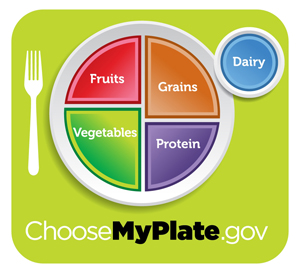On June 2, 2011, the USDA launched MyPlate, its replacement for the outdated and much-maligned Food Pyramid. The colorful quarters of the plate - green for vegetables, red for fruits, orange for grains, and purple for protein - are aimed at nudging Americans away from meals dominated by meat and starch and towards meals made up mostly of plant-based foods. 
MyPlate promotes fruits and vegetables, which cover half the circle, with grains and proteins such as meet, fish and poultry a quarter each. Dairy (e.g. a glass of milk or food, such as cheese or yogurt) rests to the side. Desserts are - well - in the desert, nowhere to be found.
Three goals
According to the the new MyPlate home page, the USDA wants Americans to:
1. Balance Calories
- Enjoy food, but eat less.
- Avoid oversized portions.
2. Increase portions of some foods
- Make half the plate fruits and vegetables.
- Make at least half of the grains whole grains.
- Switch to fat-free or low-fat (1%) milk.
- Compare sodium in foods like soup, bread, and frozen meals - and choose the foods with lower numbers.
- Drink water instead of sugary drinks.
"Brilliant in its simplicity"
Unlike MyPyramid, MyPlate offers people immediately useful information without sending them to consult their computers. It visually represents portion sizes and sends the message that a balanced meal should be at least half vegetables and fruits.
"It's brilliant in its simplicity," said Robb MacKie, head of the American Bakers Association, which represents bread makers. "It's something the average American can look at and get a visual feel for how they can fill up a plate at a real meal."
The new symbol, unveiled on June 2, 2011, with First Lady Michele Obama in attendance, is "grabbing the consumer's attention that we are after this time, not making it so complicated that perhaps it is a turnoff, said Robert Post of the USDA's Center for Nutrition Policy and Promotion. "There is something really inviting about this familiar setting for meal time."
USDA will be promoting MyPlate through social media (e.g. Twitter), with its website eventually featuring interactive tools that help people manage their weight and track exercise.
Well-received
So far, according to the Washington Post, MyPlate has been well received, especially in comparison with MyPyramid.
MyPlate is also based on better science than MyPyramid, or the granddaddy of food icons, the Food Guide Pyramid.
But, says, P.J. Skerrett, editor of the Harvard Heart Letter in a post on the Harvard Health Blog, MyPlate ignores important issues like the healthiest choices for grains, protein, and fat.
Equally important, it is silent about avoiding sugary baked goods, breakfast cereals, and drinks, as well as salty processed foods and snacks, which make up a big chunk of the average American's daily caloric intake.
One small but interesting fact lost in the hullabaloo over the launch of MyPlate, says Harvard Health: it's almost exactly the same as the New American Plate, developed in 1999 by the American Institute for Cancer Research.
Sources: "USDA replaces food pyramid with 'MyPlate' in hopes to promote healthier eating." Washington Post, June 3, 2011 (http://www.washingtonpost.com/national/usda-replaces-food-pyramid-with-m...)(accessed June 4, 2011); Harvard Health Publications press release (June 3, 2011); http://www.choosemyplate.gov/








